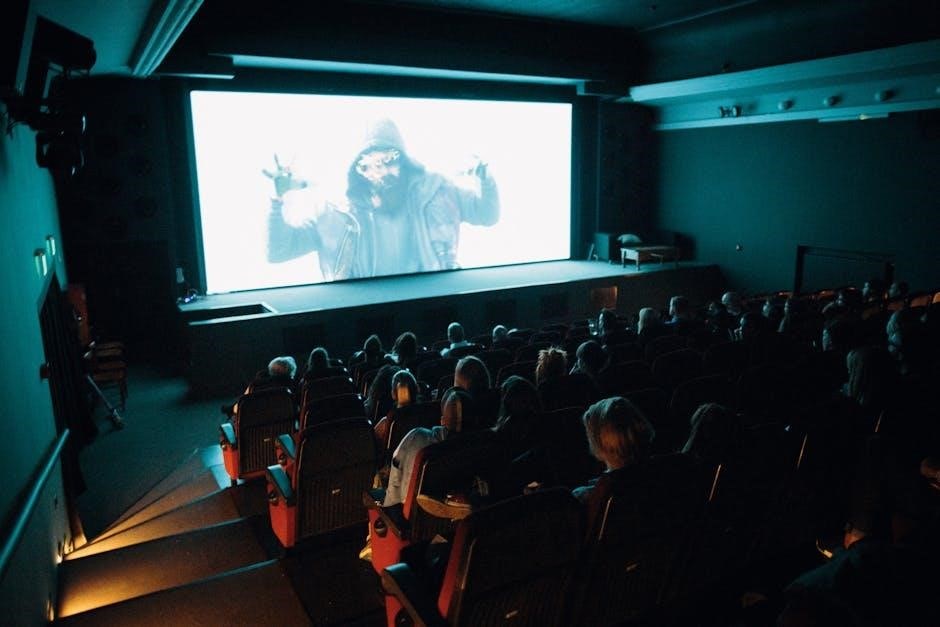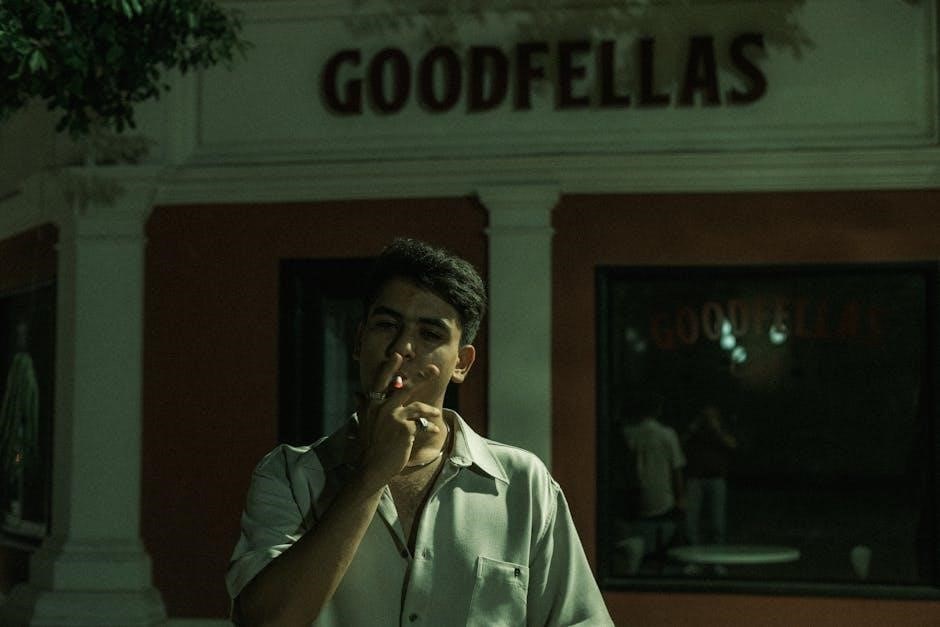The Goodfellas screenplay, written by Martin Scorsese and Nicholas Pileggi, is a masterpiece of crime storytelling, exploring themes of loyalty, betrayal, and redemption. This iconic script, adapted from Pileggi’s Wiseguy, offers unparalleled insights into the world of organized crime, making it a cornerstone of screenwriting education.
1.1 Background and Significance
The Goodfellas screenplay, co-written by Martin Scorsese and Nicholas Pileggi, is a landmark in crime storytelling. Based on Pileggi’s book Wiseguy, it chronicles the true story of Henry Hill, offering a raw, unglamorized look into the mafia world. The script’s significance lies in its masterful narrative structure, deep character development, and exploration of themes like loyalty and betrayal, making it a timeless study for filmmakers and writers.
1.2 Why the Screenplay is a Masterclass in Storytelling
The Goodfellas screenplay excels through its vivid characters, tight pacing, and layered themes. Scorsese and Pileggi’s collaboration crafted a narrative that balances action with emotional depth, creating a compelling journey from Henry Hill’s rise to his downfall. The script’s non-linear structure and voiceover narration enhance storytelling, offering a personal, immersive experience that captivates audiences and inspires writers, solidifying its status as a cinematic and screenwriting landmark.
Historical Context and Inspiration
The screenplay draws from Henry Hill’s true story, adapted from Nicholas Pileggi’s Wiseguy, blending real-life mafia experiences with Scorsese’s storytelling genius.
2.1 The True Story of Henry Hill

Henry Hill’s life as a mobster inspired the screenplay. Born in 1943, he grew up in Brooklyn, drawn to organized crime. His involvement in high-profile heists led to his downfall. Hill’s cooperation with the FBI and entry into witness protection gave him a second life, making his story a gripping tale of crime and redemption.
2.2 Adaptation from Nicholas Pileggi’s “Wiseguy”
Nicholas Pileggi’s Wiseguy chronicled Henry Hill’s mob career, providing the foundation for Scorsese’s film. The book’s detailed narrative and rich characterization were adapted into the screenplay, retaining its raw authenticity. Pileggi and Scorsese collaborated closely, ensuring the film captured the essence of Hill’s true story, blending gritty realism with compelling storytelling.

The Writing Process
The screenplay emerged from a meticulous collaboration between Scorsese and Pileggi, involving 12 drafts. Their process blended deep research with a focus on balancing action and character depth.
3.1 Collaboration Between Scorsese and Pileggi
Martin Scorsese and Nicholas Pileggi’s collaboration was pivotal in crafting the Goodfellas screenplay. Their 12-draft process involved blending Pileggi’s journalistic insights with Scorsese’s cinematic vision. The duo meticulously adapted the true story of Henry Hill from Pileggi’s Wiseguy, ensuring a narrative that balanced gritty realism with compelling storytelling. Their partnership not only shaped the film’s tone but also elevated the crime genre, leaving an indelible mark on cinema.
3.2 Key Drafts and Revisions
The Goodfellas screenplay underwent multiple drafts, with Scorsese and Pileggi refining the narrative to capture the gritty authenticity of Henry Hill’s story. The final script, dated September 8, 1989, polished dialogue and streamlined pacing. Revisions ensured emotional depth and cinematic intensity, making the film a masterclass in storytelling. These drafts are now widely studied, offering insights into the evolution of a cinematic masterpiece.

Narrative Structure and Themes
Goodfellas employs a non-linear narrative, blending style with gritty realism. Themes of ambition, loyalty, and betrayal are woven throughout, creating a compelling exploration of the criminal underworld.
4.1 The Three-Act Structure
The Goodfellas screenplay follows a classic three-act structure, masterfully guiding viewers through Henry Hill’s rise and fall. Act 1 introduces Henry’s initiation into the mob, Act 2 explores his peak as a gangster, and Act 3 chronicles his downfall. This structure enhances the narrative’s emotional impact, showcasing the consequences of Henry’s choices and the inevitable collapse of his criminal empire.
4.2 Themes of Loyalty, Betrayal, and Redemption
The Goodfellas screenplay delves into themes of loyalty, betrayal, and redemption through Henry Hill’s journey. Loyalty binds Henry to his mob family, while betrayal emerges as he becomes an FBI informant. Redemption is subtly explored in Henry’s fall from power, offering a commentary on the consequences of a glamorized criminal lifestyle and the moral decay it entails. These themes resonate deeply, making the story both gripping and thought-provoking.

Character Development
Henry Hill evolves from a wide-eyed boy to a conflicted informant, while Jimmy Conway and Tommy DeVito emerge as complex, flawed figures, each with distinct arcs. Their rise and fall reveal the human side of their criminal lives, adding depth to the narrative.
5.1 Henry Hill’s Transformation
Henry Hill’s journey evolves from a fascinated boy enthralled by mob life to a conflicted informant grappling with betrayal. His rise as a gangster is marked by loyalty and ambition, but internal conflicts and drug addiction lead to his downfall. Ultimately, his transformation into a federal witness underscores the tragic consequences of his choices, leaving him a shadow of his former self, trapped in a life he no longer controls.
5.2 Jimmy Conway and Tommy DeVito: Complex Antagonists
Jimmy Conway and Tommy DeVito are multifaceted antagonists whose charisma and ruthlessness captivate and unsettle. Jimmy, the calculating mentor, exudes charm while orchestrating brutal deeds, while Tommy’s volatile temper and ambition lead to his downfall. Their complex dynamics with Henry highlight themes of loyalty and betrayal, making them unforgettable figures in the narrative, each representing different facets of the criminal underworld’s allure and peril.

Iconic Scenes and Dialogue
The “How Am I Funny?” scene and the Copa Cabana sequence are defining moments, showcasing sharp dialogue and masterful direction that cement Goodfellas’ cinematic legacy.
6.1 The “How Am I Funny?” Scene
The “How Am I Funny?” scene is a masterclass in tension and character depth. Joe Pesci’s portrayal of Tommy DeVito, combined with Scorsese’s direction, creates a moment that balances humor and menace seamlessly. The dialogue, sharp and unpredictable, showcases Tommy’s volatile personality, making this scene one of the most memorable in cinema history, perfectly encapsulating the film’s gritty realism and emotional complexity.
6.2 The Copa Cabana Sequence
The Copa Cabana sequence is a visually stunning and emotionally charged scene that showcases Henry’s pride and the allure of his criminal lifestyle. The dynamic camera work and Scorsese’s meticulous direction immerse the audience in the glamour of the nightclub. This sequence highlights the characters’ relationships and the magnetic pull of their world, blending music, energy, and atmosphere to create an unforgettable cinematic experience that underscores the film’s themes of seduction and illusion.

Screenwriting Lessons
The Goodfellas screenplay offers lessons in crafting compelling narratives, teaching writers to create dynamic characters and sharp dialogue. The PDF is a key screenwriting resource.
7.1 Crafting Compelling Opening Scenes
The opening of Goodfellas sets the tone with Henry Hill’s iconic narration, immediately engaging the audience. By introducing Henry’s childhood fascination with mob life, Scorsese masterfully establishes character motivation and themes. This approach demonstrates how to hook viewers early while laying the groundwork for the story’s emotional depth, making it a prime example of effective opening scene craftsmanship in screenwriting.
7.2 Balancing Action and Character Depth
Goodfellas masterfully balances high-stakes action with rich character development, avoiding crime genre clichés. The script interweaves intense sequences, like the Copa Cabana scene, with emotional arcs, such as Henry’s rise and fall. Scorsese’s pacing ensures that action complements character growth, creating a narrative where both spectacle and depth coexist seamlessly, keeping audiences invested in the story and its complex figures.
Accessing the Goodfellas Screenplay
The Goodfellas screenplay can be accessed as a PDF from platforms like IMSDb, The Daily Script, and Script City. Multiple drafts are available for educational study and analysis.
8.1 Where to Find the PDF
The Goodfellas screenplay PDF is available on various online platforms. Websites like IMSDb and The Daily Script offer the January 31, 1989, revised final draft. Additionally, Script City provides the September 8, 1989, revised version. These sources ensure easy access for writers and filmmakers seeking to study this iconic script. Multiple versions are listed to cater to different educational needs, making it a valuable resource for screenwriting enthusiasts.
8.2 Analyzing the Script for Educational Purposes
Studying the Goodfellas screenplay offers invaluable insights into storytelling techniques, character development, and thematic depth. The script’s tight structure, vivid dialogue, and layered characters provide a masterclass for aspiring writers. Analyzing scenes like the Copa Cabana sequence or the “How Am I Funny?” moment highlights how to craft tension and emotional resonance. It serves as a powerful educational tool for understanding narrative craftsmanship and the nuances of screenwriting.
Goodfellas remains a timeless masterpiece, offering profound insights into storytelling, character complexity, and thematic depth. Its enduring influence on modern screenwriting solidifies its legacy as a cinematic treasure.
9.1 The Legacy of Goodfellas
Goodfellas is celebrated as a landmark in cinema, redefining the crime genre with its raw authenticity and gripping narrative. Its influence on modern storytelling is immense, inspiring countless filmmakers. The screenplay’s meticulous structure and rich character development make it a timeless study for writers. Scorsese and Pileggi’s collaboration crafted a masterpiece that continues to resonate, ensuring its enduring legacy in both film history and screenwriting education.
9.2 Its Impact on Modern Screenwriting
The Goodfellas screenplay has profoundly shaped modern screenwriting, influencing crime dramas and beyond. Its non-linear narrative, vivid character arcs, and intense dialogue set new standards. Filmmakers study its structure for crafting compelling openings and balancing action with depth. The script’s authenticity and thematic richness continue to inspire writers, solidifying its role as a foundational study in the art of screenwriting.

